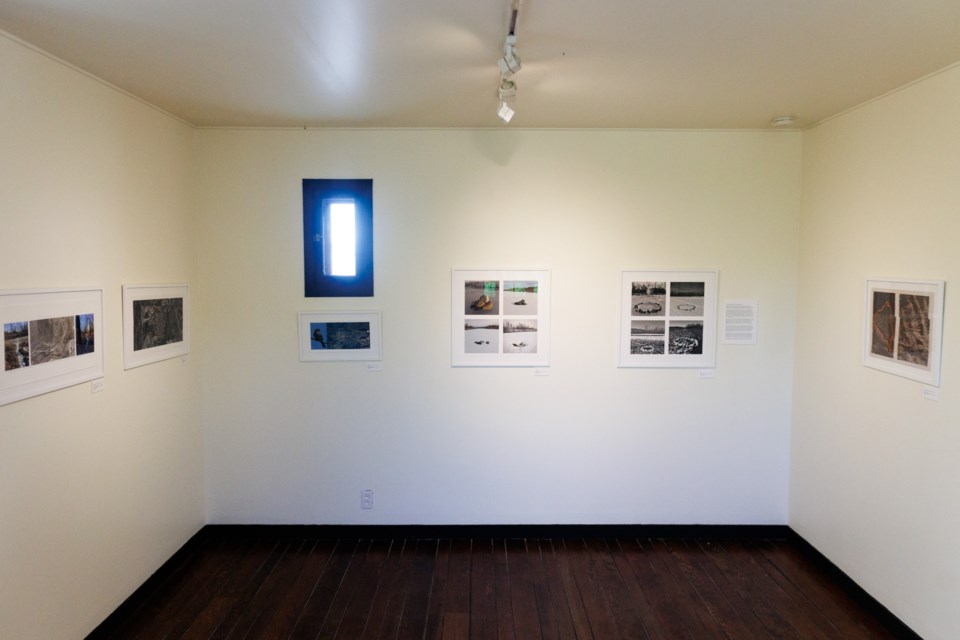The Foothills’ most historic art gallery has two new exhibitions.
Showing through October are walking is traditional by Dene-Scottish artist Bruno Canadien of Diamond Valley, and Hey You! Land! by the Ways of Making artist ensemble from the National accessArts Centre (NaAC).
Hey You! Land! by Ways of Making, NaAC
The Ways of Making was an initiative to enable artists with disabilities to engage in conversations and learning about Indigenous histories and artistic practices, working with guest faculty on the importance of representation, artistic practices, and issues of cultural appropriation.
“This exhibition came out of the Ways of Making at the NaAC, which is a group of artists that explore indigenous histories and artist,” said Katie Wackett, co-ordinator of artistic projects at the NaAC.
“Generally, people with disabilities think they can’t engage in those tough conversations about truth and reconciliation and expanding knowledge about Indigenous communities.”
Among those in the multi-medium exhibition are Kathy M. Austin, Pudge Cuch, Daniel Desaulniers, Cherie Morgan, Meg Ohsada, Andre Paradis, and Kacy Salkeld.
For Kathy M. Austin, who is legally blind, the experience in the program has been invaluable.
Part of Austin’s contribution is a dance, filmed outside the Leighton Centre.
“I use a rain stick I made, and the other part I use my cane,” Austin said. “There’s a voiceover that goes with this video where I read two of my poems, and I read from a dream journal that I wrote in 1998.”
The artist also painted Austin’s childhood home from a photograph she took in 1985, before a relative had let the house become derelict and inhabited by feral cats and it was demolished.
“It was a house that dad had built and spent 26 years of his life in,” Austin said. “So I did the painting in a sort of dreamy ghost-like fashion, because the house doesn’t exist anymore.”
Being enabled by funding from the NaAC has been a major boost for Austin.
“As a blind person I haven’t ever been able to get paid for my work,” she said. “But I also do it as way of self-expression and just think if I didn’t write and do art my head would probably explode.”
Austin originally got involved with the Artistic Expressions, a non-profit for adults with physical disabilities or acquired brain injuries.
“I joined that in 2008 – well, I was literally plucked off the street,” she said.
That organization ultimately merged in 2020 with the In-Definite Arts Society to become the NaAC, Canada’s first multidisciplinary disability arts organization.
“People with disabilities are not represented in most of the media, more specifically in art galleries, so it's important that I be a part of this movement to expose the general public to the wonderful things that people with disabilities can do,” Austin said.
walking is traditional, Bruno Canadien
Canadien draws on the love for walking from both his Dene and Scottish heritage.
"What I do is exploring walking as an art practice, incorporating walking practices I already had into art practice, incorporating walking practices I already had into art practice,” said Canadien.
“So for these works what I’ve done is create digital artifacts of the walk.
“Photographs, audio recordings, GPS tracks, I keep a bird list, all these things are digitally recorded then I get back to the studio and work with those bits of material and have been using photo collages from them.”
His own family’s tradition of walking goes back generations, growing up in the Northwest Territories as the child of a Dene mother and Scottish father, and the grandson of a mountaineer.
“My heritage from both sides informs my work for sure,” Canadien said, adding trips down to the Rockies were frequent growing up.
“My father, he’s from Scotland, would take us on hikes when we were younger.
“My dad just sort of set the example of walking as a regular practice, and my grandfather was actually a mountaineer; he would do excursions in the Swiss Alps, and we have a collection of postcards from the Swiss Alps.”
Drawing on his Indigenous roots, walking is also simply about connecting to the Earth.
“So drawing on that tradition and just using walking as a way to be on the land, as a way to connect to this area,” Canadien said. "My nation isn’t from this area, we’re from the Northwest Territories, but I view it as a good way to build a relationship with the land, no matter where you are.
“Obviously more traditional uses of land aren’t available to many First Nations, especially in southern Canada.”
While far from where he grew up, there are similarities, he added.
“This landscape is not so different from the landscape of the north, there’s many similarities,” Canadien said.
Residents and those fond of the Foothills may know the paths Canadien walked, from the mountains out to the river valleys.
“A lot of these walks in this exhibition are done in the Sheep River watershed,” he said.
“There’s a few walks I've done in Black Diamond, several other pieces are done on walks I did up in Kananaskis, Brown Lowery (Provincial Park), and at the Leighton Centre.
“That’s part of the show: I wanted to underline the importance of local spaces, the availability of greenspaces in Black Diamond, Turner Valley and the Foothills.”
The exhibitions are on display through to Oct. 29. For more information visit leightoncentre.org.




